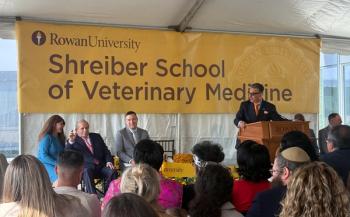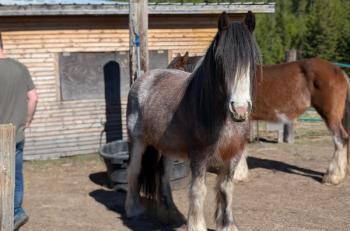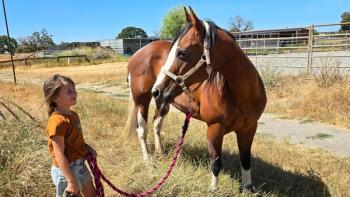
Foal diarrhea: causes, diagnosis and treatment (Proceedings)
Diarrhea is a significant cause of morbidity and mortality in foals. Numerous noninfectious and infectious agents are responsible for enterocolitis and enteritis in the newborn foal.
Diarrhea is a significant cause of morbidity and mortality in foals. Numerous noninfectious and infectious agents are responsible for enterocolitis and enteritis in the newborn foal. Altered fecal consistency may be associated with uncomplicated diarrhea which often does not require treatment, to life threatening enteritis or enterocolitis with endotoxemia and clinical signs associated with systemic inflammation. Associated metabolic complications include acidosis, hypovolemic shock, hypotension, and bacteremia. Therapy is dependent on the severity, suspected etiology and concomitant complications. Supportive care and rehydration to prevent hypovolemic shock and renal damage can be life threatening. Antibiotic therapy is only required if bacterial enteritis is suspected or if there is the possibility for bacterial translocation across the compromised gastrointestinal tract.
"Foal heat" diarrhea
Mild diarrhea without signs of systemic disease or inflammation is commonly observed in foals between 5 and 15 days of age. Foals remain bright and alert, continue to nurse and no abnormalities are present on hematology and biochemistry results. The term "foal heat" is a misnomer, as diarrhea also occurs in orphan foals raised on milk replacement formulas.
Although not proven, it is postulated that maturational changes of the gastrointestinal (GI) tract associated with initiation of feed ingestion and inoculation of microflora by coprophagy resulting in the establishment of normal GI flora, are responsible for the altered fecal consistency. Foals should be monitored closely for any signs of systemic disease, including depression, dehydration, fever or reduced appetite, as early enteritis can mimic foal heat diarrhea. No treatment is required for foal heat diarrhea, however cleaning the perineum and topical application of Vaseline, or a Zinc Oxide preparation can help prevent scalding.
Mechanical irritation by sand or foreign material
Ingestion of sand, dirt, shavings, rice or almond hulls can cause mechanical irritation to the GI tract and subsequent diarrhea. Colic and abdominal distention are commonly present with these forms of diarrhea. Diagnosis is easily made evaluation of the feces. Abdominal radiography can be used to definitively diagnose radio-dense material such as sand, and with practice ultrasonography can also be used.
Treatment of foals with sand accumulation includes supportive care with intravenous fluid therapy and enteral laxatives, including mineral oil and psyllium. Occasionally, foals with sand impactions require surgical evacuation.
Hypoxic gastrointestinal damage
Peripartum asphyxia syndrome, also referred to as hypoxic-ischemic encephalopathy or "Dummy foal syndrome" can result in ischemic damage to the GI tract, kidneys, heart and brain. Any cause of poor oxygen delivery in the peripartum period resulting from dystocia, cesarean section, umbilical cord problems, or abnormal oxygenation in the immediate postpartum period can result in hypoxic gut injury secondary to hypoperfusion, ischemia-reperfusion injury, and inflammatory mediators. Clinical signs associated with ischemic gastro or enterocolitis include gastroduodenal reflux, ileus, intolerance to enteral feeding, colic, abdominal distention, and diarrhea.
These foals often require intensive care due to renal, cerebral and cardiac dysfunction. Foals with asphyxia-associated diarrhea should be monitored for nasogastric reflux, bloating (bloat-tape) and gastrointestinal distension and motility by ultrasonographic examination. They should be fed very conservatively through the enteral route (initially only 3-5 % of their body weight in mare's milk divided into hourly feedings: ie ~ 100mls/hr). For the initial 24 hours, nutrition can be supplemented by the addition of 5-10% dextrose to balanced electrolyte solutions administered at 60-120 mls/kg/hr, depending on the degree of dehydration and on-going gastrointestinal losses. Parenteral nutrition, with only small volumes of enteral milk to provide local nutrients to enterocytes is beneficial in severely affected foals. Partial gastrointestinal rest can prevent reflux, bloating and diarrhea. These neonates are at high risk of developing sepsis, and broad-spectrum systemic antimicrobial therapy is recommended.
Nutritional causes of diarrhea
Foals fed with milk replacer develop loose feces more frequently often than those fed mare's or goat's milk, especially if erroneously made either too concentrated or too dilute.
Lactose intolerance
Lactase is made by the cells in the tips of the small intestinal mucosal brush border. Primary lactase deficiency is rare in foals, but lactase deficiency secondary to damaged intestinal villi tip cells by infectious agents such as rotavirus and Clostridium difficile is not uncommon.
Supplementation with a lactase is indicated in foals with suspected lactase deficiency. Although lactose intolerance can be confirmed with a lactose tolerance test, as supplementation is inexpensive, practical and safe, testing is not usually performed.
Infectious causes
Viral enteritis
Rotavirus is the most common viral cause of neonatal diarrhea and may occur as outbreaks on farms in foals between 5 and 35 days old. Rotavirus is highly contagious and the incubation period as short as only 2 days. Older foals can be infected, although diarrhea tends to be milder, they can serve as reservoirs for neonates and should be isolated when identified. Transmission occurs by direct foal-to-foal contact and indirectly through personnel, fomites or environmental contamination. The virus affects the small intestine, causing blunting of the microvillus. Maldigestion (lactose intolerance) and malabsorption result. With villous atrophy and compensatory crypt cell proliferation, there is a net decrease in fluid absorption and an increase in secretion. With maldigestion, lactose may enter the colon, with subsequent fermentation and osmotic diarrhea. Clinical signs of rotaviral diarrhea are similar to those of other infectious diarrheas, and range from sub-clinical to mild diarrhea to severe, watery diarrhea with dehydration.
Rotaviral infections are diagnosed through the demonstration of virus particles in feces using commercial immunoassays or electron microscopy. Affected foals should be strictly isolated as morbidity can approach 100% in an outbreak. Disinfection with substituted phenolic compounds or quaternary ammonium should be performed. The virus can persist for several months in the environment.
Treatment of rotaviral diarrhea is largely supportive, and with good care mortality rates are low. Vaccination of mares during gestation is controversial, with mixed results reported.
Coronavirus is another rarely reported cause of viral enteritis in foals. An antemortem diagnosis of coronaviral enteritis can be made using fecal-capture ELISA, electron microscopy, and serology using bovine assays. The highest viral load appears to be shed in the feces during the acute stages, highlighting the importance of an early diagnosis and isolation. Immunohistochemistry can be used at postmortem examination.4
Bacterial sepsis
Twenty-five percent of blood culture positive septic neonatal foals develop diarrhea. Although Escherichia coli is one of the most common causes of sepsis in foals, it has only rarely been associated with diarrhea. E coli isolates, particularly enterotoxigenic strains that commonly infect calves and piglets are considered a rare cause of diarrhea in foals. As E coli is commonly cultured from the feces of horses and foal, polymerase chain reaction analysis for toxin genes is required to diagnose toxin producing strains.
Salmonellosis
Salmonella spp. can cause enterocolitis in horses of any age. Enterocolitis in foals may be accompanied by Salmonella spp. bacteremia, with signs of sepsis, including fever, diarrhea, depression, and hypotensive shock. Colic and hemorrhagic diarrhea may also occur. Localized infection, including uveitis, synovitis, osteomyelitis, and physitis are further complications of Salmonella spp. bacteremia. As salmonella sheds intermittently, total of 5 negative fecal cultures rules out salmonella infection. PCR can also be used. All neonatal foals with enteric salmonellosis should also have a blood culture performed, and be treated with systemic antimicrobials that are effective against salmonellae, including aminoglycosides or third-generation cephalosporins. The antimicrobials will have little effect on clearing the salmonella from the GI tract, but can treat bacteremia, localized infection or bacteria that translocate across the compromised GI wall. Strict isolation is recommended for several months until shedding has ceased. Farm outbreaks can occur.
Clostridium difficile and Clostridium perfringens
Clostridium perfringens and C difficile are common causes of enterocolitis in foals. C perfringens isolates are typed as A, B, C, D, and E, based on the production of exotoxins (α, β, β-2, ε, and enterotoxin). Polymerase chain reaction is used to type isolates for toxin gene sequences after isolates are cultured.6 Commercial immunoassays for toxin detection in feces are available only for enterotoxin, which is present only in a minority of cases.
Types A and C are most commonly associated with diarrhea in foals less than 10 days of age. Infected foals may be subclinical or have severe hemorrhagic diarrhea. Type C is more severe, with a higher mortality (83%) than type A (28%). Other clinical signs include colic, dehydration, tachypnea, and depression. Foals born on dirt, sand, or gravel and those kept stalled or in dry-lot conditions during the first 3 days of life are at a higher risk of developing C perfringens diarrhea. Common hematologic findings include leukopenia with neutropenia, increased band neutrophils, toxic changes, and hyperfibrinogenemia. Hypoproteinemia is common, but can be masked by hemoconcentration from the severe dehydration. Although most foals have adequate passive transfer of colostral antibodies foal bebefit from plasma transfusion after rehydration. Many foals may have hyperbilirubinemia, azotemia, and increased hepatic enzymes. Abdominal ultrasonography and radiography may show gas- and fluid-distended small and large intestines.
C difficile also a normal gut commensal in foals, but can produce enteritis, with severe, watery to hemorrhagic diarrhea. Diagnosis is by a combination of fecal culture and toxin assays. Commercial immunoassays for toxins A or B and fecal cell culture cytotoxin assays (for toxin B) allow for the differentiation between toxigenic and nontoxigenic infections. As for C perfringens, a fecal smear showing large numbers of gram-positive rods or spores suggests clostridial overgrowth.
Therapy for clostridial enterocolitis includes intensive and supportive care with correction of fluid, acid–base, and electrolyte derangements. Hypoproteinemia or hypoalbuminemia is treated with administration of plasma or synthetic colloids. Affected foals should be monitored for the development of coagulopathy, for which plasma or low-molecular weight heparin may be necessary. Specific therapy includes the early use of metronidazole. Some C difficile isolates from foals have been reported to be resistant to metronidazole, and vancomycin has been used in those circumstances. Biosponge® has been shown to neutralize toxins in vitro. Anecdotal reports of C perfringens type C and D antitoxin after pretreatment with diphenydramine has been reported in foals. Supplementation with lactase enzyme is warranted due to the small intestinal mucosal brush border.
Strict isolation should occur. Spores are almost impossible to eliminate, but numbers can be reduced with fecal removal, scrubbing and subsequent disinfection with bleach. Prevention depends on good hygiene, particularly in the foaling area.
Other causes
Aeromonas hydrophila is cultured from about 30% of diarrheic foals at Auburn University, but its exact role in diarrhea is currently unknown. It appears that aeromonas infection has an equal mortality rate to salmonellosis. Aeromonas is the most common cause of traveler's diarrhea in humans.
Cryptosporidium parvum has been associated with sporadic and outbreak cases of diarrhea in foals.4 Diagnosis is by fecal sample evaluation for oocysts after acid-fast staining, immunofluorescence assay, electron microscopy, or flow cytometry. Treatment includes supportive care, although the use of bovine colostrum has been recommended. Aminoglycoside paromomycin could be attempted, although data in foals is not available. Strict isolation is recommended as Cryptosporidium parvum is both contagious and zoonotic.
Other protozoa, including Giardia and Eimeria can be found in both healthy and diarrheic foals, but their causal role in foal diarrhea has not been established.
Drugs, dosages and indications
Foal diarrhea summary
Neonatal diarrhea can be physiologic, or pathologic from a combination of viral, bacterial or parasitic causes. Salmonella and Clostridia tend to be invasive, resulting in loss of mucosal barriers and in the severe form fibrino -hemorrhagic necrotic enteritis. In contrast, Rotavirus infects the mature brush border villous epithelial cells of mainly the small intestine. Infected ells are sloughed leading to villus atrophy. Lactase producing villous cells are lost leading to decreased utilization of lactose. Malabsorption leads to diarrhea, dehydration and loss of electrolytes ands acidosis
Diagnostic tests
Fecal tests for Rotavirus, C. perfringens and C. difficile, cultures for Salmonella and Aeromonas (daily for 5 days). Blood for CBC, fibrinogen, biochemical profile, IgG and culture.
Therapeutics
• Rotavirus: lactase
• Clostridia: metronidazole
• Salmonella: amikacin or cefotaxime or ceftriaxone
• Isotonic electrolytes: 80-150 mls/kg/day depending on degree of dehydration
• Shock rate: 60-90 mls/kg for 1 hour
• Half strength fluids (0.45% NaCl may be required to prevent hypernatremia)
• Additions to fluids: dextrose (3-10% = 60-200 mls of 50% solution), KCl = 20-40 mEq/L, calcium gluconate 23% = 10-20 cc/L
• Bicarbonate deficit = (0.4 x BW(kg) x deficit)/ 12 = mEq of bicarbonate/d =4 mEq PO q 8 h.
• Plasma 1-3 L /50 kg foal IV
• DO NOT ADMINISTER CORTICOSTEROIDS, LASIX
• CARE with repeated dosages of NSAIDs (monitor hydration and serum creatinine concentration)
Prognosis
Enteroinvassive causes of diarrhea often require intensive care in an isolation facility due to the highly infectious nature of the disease. Prognosis with intensive care can be fair to very good depending on the extent of the disease at the time of referral. Foals that are still bright and nursing may recover spontaneously.
Newsletter
From exam room tips to practice management insights, get trusted veterinary news delivered straight to your inbox—subscribe to dvm360.






